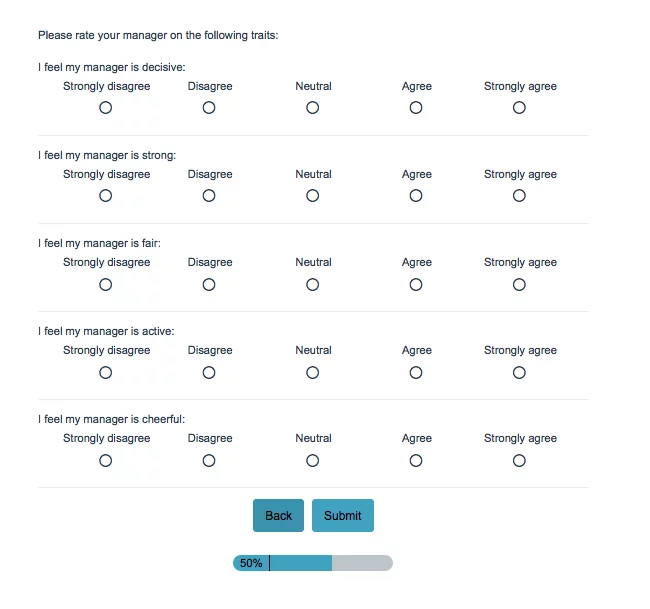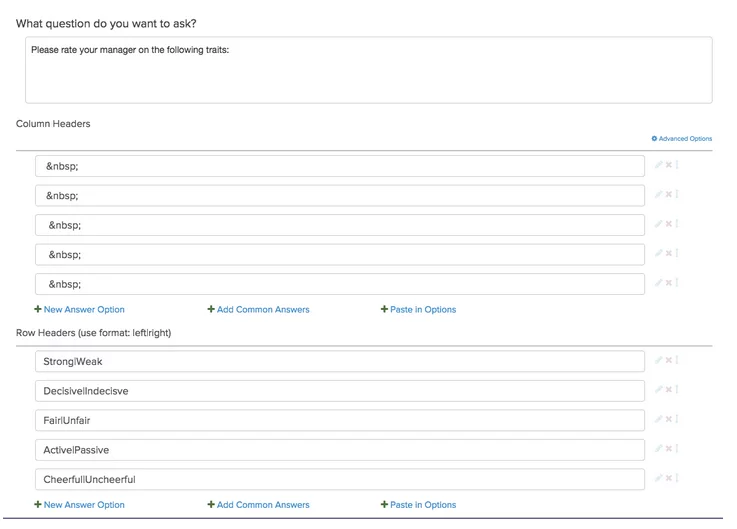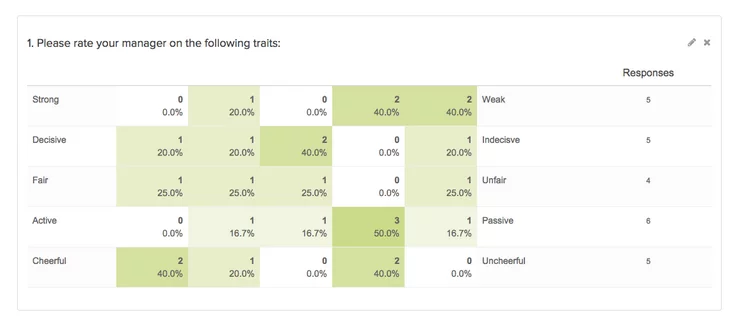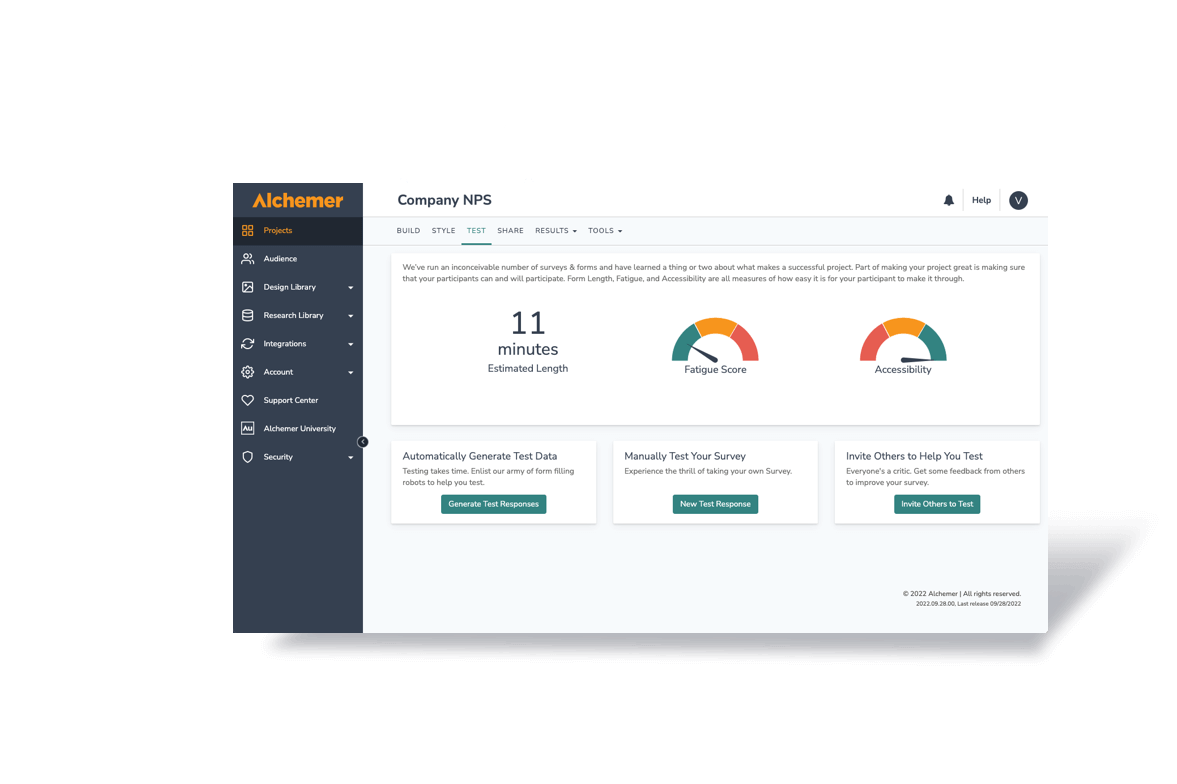In survey design, accurately measuring respondents’ attitudes can be challenging. Two common methods to capture attitudes and feelings are the Likert scale and the semantic differential scale. Understanding the differences between these scales, their applications, and how to set them up can significantly improve your data quality. This blog will focus on semantic differential scaling, explain how it differs from the Likert scale, and provide examples of how to use both effectively.
What is the Semantic Differential Scale?
The semantic differential scale is a type of rating scale designed to measure the connotative meaning of objects, events, or concepts. Developed by Charles E. Osgood in 1957, it uses bipolar adjectives (such as “happy-sad” or “strong-weak”) and asks respondents to place themselves between two extremes. This allows the survey designer to measure a person’s attitude or emotional response to the subject being studied.
For example, instead of asking, “Do you like this product?” you might ask respondents to rate the product on a scale between “like-dislike” or “useful-useless.” This method offers a flexible and nuanced way to gather attitudinal data.
The semantic differential scale is commonly used in fields like psychology, marketing, and education to capture attitudes that are more complex or nuanced than a simple “yes” or “no” answer can provide.
Examples of Semantic Differential Scales
To clarify how semantic differential scaling works, here are some typical semantic differential scale examples:
- Happy | Sad
- Strong | Weak
- Exciting | Boring
- Active | Passive
- Attractive | Unattractive
- Efficient | Inefficient
Respondents would mark their feelings or attitudes on a scale, usually with five or seven points, that ranges between these two opposite adjectives. Each point on the scale represents a different degree of the respondent’s position between the two adjectives. The use of these bipolar pairs allows survey creators to pinpoint the exact semantic difference in respondents’ attitudes and behaviors.
When to Use Semantic Differential
As an example, let’s say we’re conducting an employee evaluation of their managers. We could use Likert scale questions like these:

Or you could use this:

Which do you think looks easier for the respondent?
When using the Likert scale questions, if you say, “I feel my manager is decisive,” the way you are using “decisive” could influence the survey respondent and give you less than accurate feedback.
You could go the other direction and say, “I feel my manager is indecisive,” but then you would have the same problem.
Semantic Differential to the rescue!
Semantic differential scales are ideal when you need to measure attitudes, opinions, or feelings that involve multiple dimensions. These scales can be used in a variety of fields, such as:
- Market research: Gather insights on how consumers feel about a product, brand, or service. For example, to assess consumer reactions to a new product, you might ask them to rate it on a series of semantic differential scales, such as “Affordable | Expensive,” “Innovative | Traditional,” and “Durable | Fragile.”
- Employee evaluations: Understand staff perceptions about management or company culture. Instead of asking employees to agree with a statement like “My manager is supportive,” you could use a semantic differential scale like “Supportive | Unsupportive” to allow employees to give a more balanced view of their manager’s behavior.
- Psychology and therapy: Measure patients’ feelings toward specific life events, people, or issues. In therapy, for instance, a patient might be asked to rate their mood on a scale from “Optimistic | Pessimistic” to assess how their feelings have changed over time.
In all these cases, the semantic difference between the opposing adjectives provides a valuable way to explore respondents’ emotional or cognitive reactions more thoroughly.
Likert Scale vs. Semantic Differential Scale
Both the Likert scale and the semantic differential scale are popular tools for gathering attitudinal data, but they are used in different ways, and understanding the distinction is critical for effective survey design.
- Likert Scale: This scale asks respondents to indicate their level of agreement or disagreement with a statement. For example:
- “I feel my manager is decisive.”
- Respondents would then select a response along a scale, typically ranging from “strongly agree” to “strongly disagree.”
- Semantic Differential Scale: In contrast, the semantic differential scale presents respondents with two opposing adjectives, asking them to indicate where they fall on the continuum between them. For example:
- “Decisive | Indecisive”
- Respondents would rate their manager by selecting a position between these two adjectives.
Comparing Likert scale vs. semantic differential scale, the semantic differential scale provides a more nuanced look at attitudes by allowing respondents to freely position themselves between two extremes, rather than being influenced by the phrasing of a statement, which can introduce bias.
Advantages of the Semantic Differential Scale
Semantic differential scales have several key advantages over likert scales in certain contexts:
- Flexibility: Semantic differential allows for a wider range of concepts to be measured. You’re not limited to agreement or disagreement; instead, you can capture subtle distinctions in feelings or attitudes across multiple dimensions.
- Reduced Bias: By avoiding terms like “agree” or “disagree,” you minimize response bias, particularly when measuring attitudes on sensitive or subjective topics.
- Deeper Insights: The semantic difference between two opposing adjectives can reveal complex emotions that aren’t always captured through traditional Likert-type questions. It’s a powerful tool when you want to delve deeper into respondents’ subconscious attitudes.
In contrast, likert scales are often easier to interpret for certain types of data, especially when you are looking for straightforward measures of agreement or disagreement. However, they may lead to a “central tendency bias,” where respondents avoid selecting the extreme ends of the scale and instead opt for neutral responses.
Applications of Semantic Differential Scales in Various Fields
The ability of semantic differential scales to explore attitudes and emotional responses has made them popular across a variety of industries and fields. Here are some additional applications where they are particularly valuable:
- Brand perception studies: Companies often use semantic differential scales to understand how consumers perceive their brand. Respondents might be asked to rate the brand on dimensions such as “Innovative | Traditional” or “Affordable | Expensive” to gather nuanced data about consumer sentiment.
- Political polling: In political surveys, semantic differential scales can measure voters’ perceptions of candidates or issues. For example, voters might be asked to rate a candidate on a scale from “Trustworthy | Untrustworthy” or “Experienced | Inexperienced.”
- Educational assessments: Schools can use semantic differential scales to evaluate students’ attitudes toward specific subjects, teachers, or school policies. This allows educators to gain a more comprehensive understanding of student engagement and satisfaction.
- Product development: Semantic differential scales are also useful in product testing, allowing companies to understand consumer perceptions of a new product’s features. Scales such as “Easy to use | Difficult to use” or “Attractive | Unattractive” provide valuable feedback that can guide design and marketing decisions.
Setting Up a Semantic Differential Question
Designing a semantic differential question is straightforward, especially when using a survey tool like Alchemer. Here’s a step-by-step guide:
- Add a Question: After creating your survey, add a question and select “Semantic Differential” as the question type.
- Input Bipolar Adjectives: In the row headers, input your bipolar adjectives such as “Strong | Weak” or “Exciting | Boring.” These adjectives represent the two extremes of the attitude or perception you’re measuring.
- Define the Scale: You can set the scale as a 5-point or 7-point scale, depending on the level of precision you want. This gives respondents multiple points to express their attitudes.
- Customize Columns: Choose how many columns you want between the two extremes. You can label these with numbers (1-5) or leave them blank.
Once you’ve configured your question, you can preview it and make sure it’s easy for respondents to understand. Semantic differential scales are highly intuitive for respondents, making them less likely to cause confusion or misinterpretation.
To deploy this powerful tool in your own Alchemer surveys, add a question to your survey and select question type. Scroll down to ‘advanced’ and you will find Semantic Differential.

You can then enter your instructions to your respondent under, “What question do you want to ask?”

Then you can set up your column headers. You might use 1-5 as a column header, or if you prefer blank column headers like in my example you can enter this code:
That code is short for non-breaking space; it allows the column headers to remain blank.
In the row headers you can enter the bipolar adjectives that the respondent will see in this format: Strong|Weak.
(The symbol between the adjectives is the pipe symbol. It is usually located above and to the right of the enter key on most keyboards.)
Make sure to save your question, and you’re all set.
Reporting and Statistical Properties
Semantic differential questions in Alchemer report as a table with values and percentages for each option, along with the total number of responses. In my example, I created ten test responses for the managerial review question.
Here is what the summary report would look like:

Our test data generating robots are fairly random. However, when taken by live respondents, trends (or the lack of them) would be readily apparent.
Conclusion: Likert Scale vs. Semantic Differential
Understanding the difference between Likert scales and semantic differential scales is key to choosing the right tool for your survey. If you’re aiming to measure agreement or disagreement with statements, the Likert scale is an excellent choice. However, if you need to explore deeper attitudes and feelings with greater nuance, the semantic differential scale is more suitable.
In summary:
- Use the Likert scale for straightforward opinion questions where you want to gauge levels of agreement or satisfaction.
- Use the semantic differential scale when you want to measure attitudes, perceptions, or feelings along multiple dimensions without imposing specific statements.
Both scales have their place in effective survey design and knowing when to use each will help you gather more accurate and meaningful data.
For more insights on using semantic differential scaling in your surveys, explore Alchemer’s comprehensive documentation on advanced question types.



